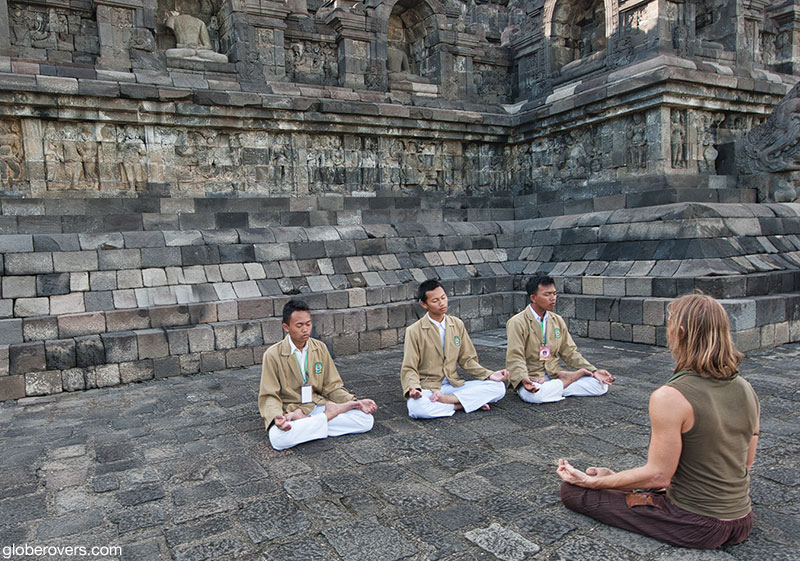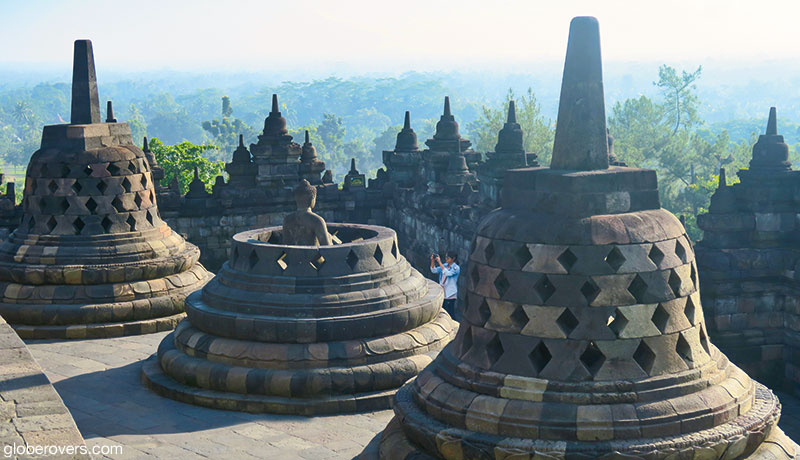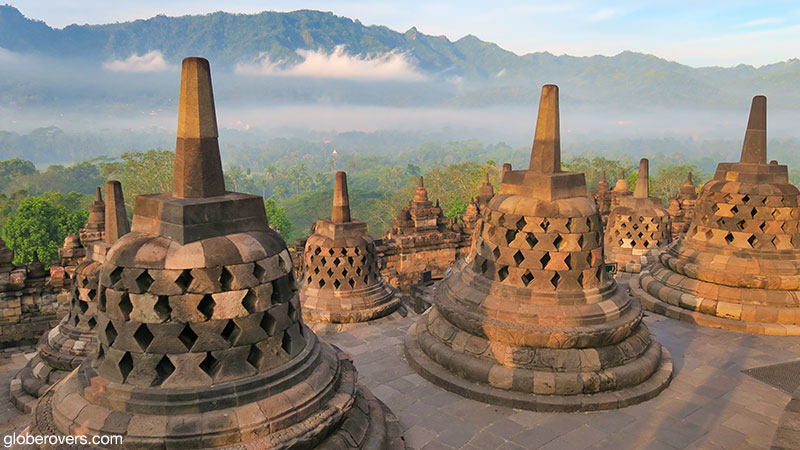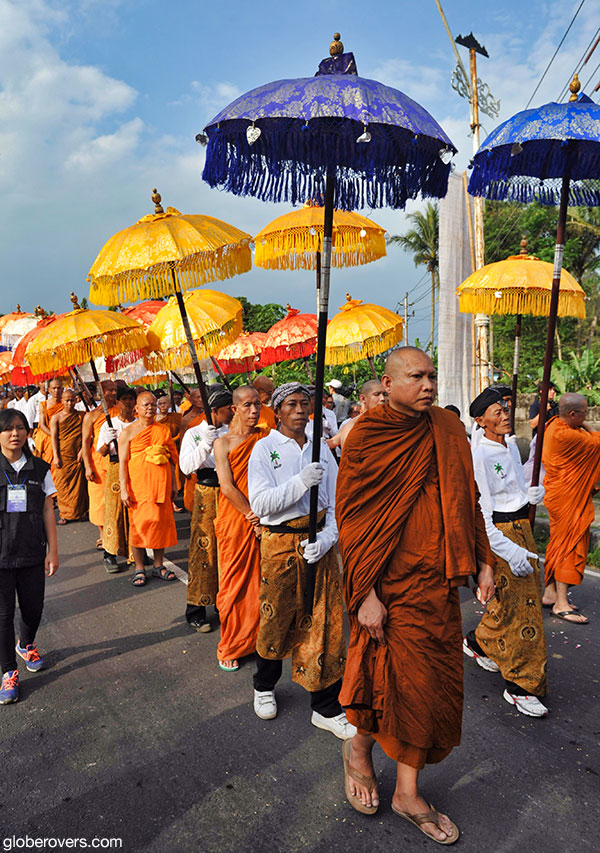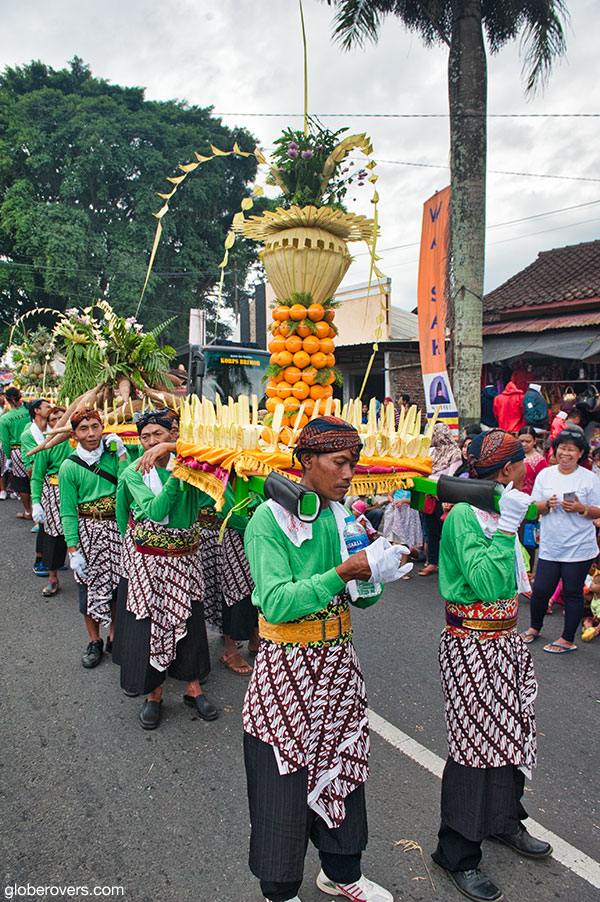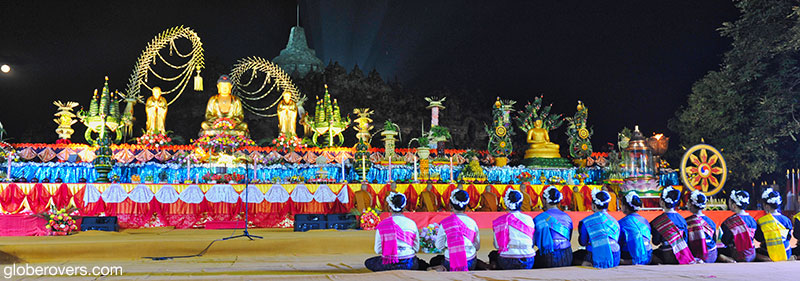
Borobudur, Indonesia – Vesak Day (also written as Wesak) is traditionally observed by Buddhists and some Hindus as “Buddha’s Birthday” which commemorates the birth, enlightenment (Buddhahood), and the death (Parinirvāna) of Gautama Buddha.
This is the time of the year to be at Borobudur Temple. This is the day to let your mind go wild and fantasize about an ancient temple lost for centuries in the dense tropical jungle, only to be rediscovered by you whilst riding on an Asian elephant. That may be an exotic dream, but you should have been here in the early
Celebrate Vesak Day at Borobudur temple and witness as the sunrise over the smouldering Merapi volcano casting hues of pinks and blues over the ruins. Surreal.
At the time when the remains of the 9th century ruins of Borobudur temple were rediscovered in 1814, it looked very different from what we see today.
Why travel to Borobudur Temple?
- The low-down: Borobudur is one of the world’s greatest temple ruins and a must-visit-before-you-die place. Either visit during a festival such as Vesak
Day, or go off-season to beat the crowds. - The brightest highlight: Vesak Day at Borobudur Temple is truly special, in
particular the evening performance and the all-through-the-night monks’ chanting. - Intrepid destination: While no longer an intrepid destination, if you visit during the off-season and enter before sunset, you will be one of few visitors walking on and around the temple.
- Globerovers score (10 is highest): This is a must-do for most every traveller out there so you won’t be disappointed with Borobudur. We have no choice but to give it a score of 9.

What we see today is even different from just 10 or 20 years ago. It’s not so much the ruins themselves that changed over the past decade or two, but the increase in the number of visitors. Gone are the days when you could feel like a lonely jungle explorer at Borobudur.
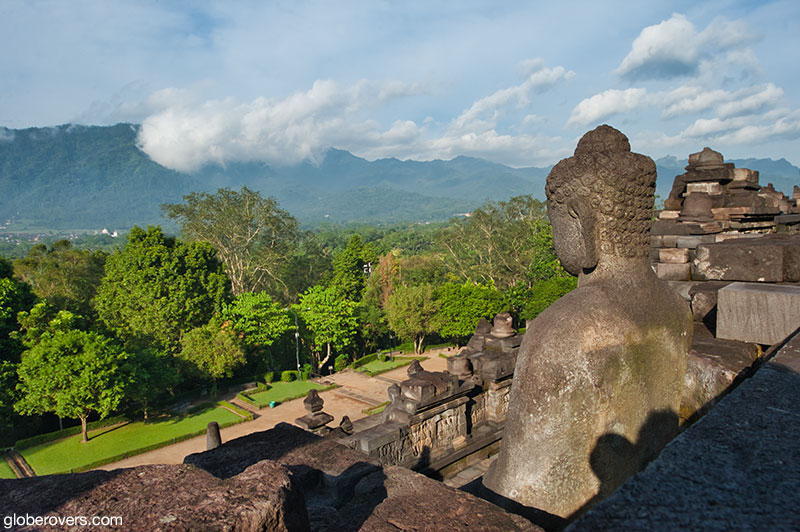
As you approach the large car park, the modern entrance gates, and the line-ups of people, you may feel like turning around! The Borobudur Temple Tourist Park Management reported that Borobudur received close to four million visitors in 2016. Back in 1974, only about 260,000 tourists visited, including 36,000 foreigners.

For most travellers to Indonesia’s Central Java region, the ruins of Borobudur temple are the highlight of their visit and the main reason for coming here. For many, Borobudur is the only place they will visit before they fly out to faraway places.
Borobudur can get crowded, very crowded, especially during the annual celebration of Vesak Day.
Borobudur is a crown jewel in the world’s collection of ancient temple ruins. Be here on Vesak Day.
On Vesak Day, Thursday May 11th 2017, about 40,000 devotees flocked through the gates! Also on location were about 3,500 merchants, and over 70 tour guides. Get the picture?
Don’t despair! Visit Borobudur in January, February or March, reliably the wettest time of the year, and you will find significantly fewer visitors. July and August are usually the driest months, but the heat and high level of humidity can make a full-day visit unbearable.
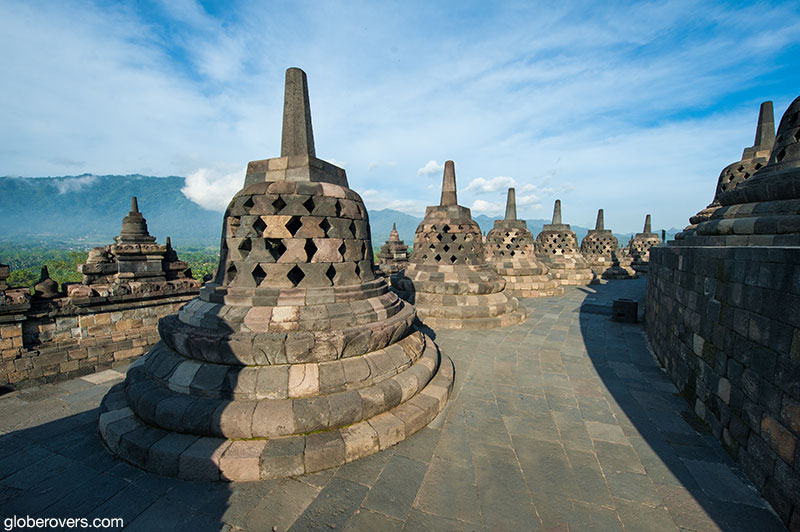
So, while you can find times of the year when fewer people visit, it is a surreal experience to be here during the Vesak Day festival when orange-robed monks descend from all over Asia!
Festivities start early in the morning with a Buddhist mass prayer and meditation at the nearby 9th century Mendut temple. A very colourful and long, slow-moving parade then leaves the temple, passing by the 9th century temple of Pawon, and 4 km later delivers the holy water and eternal flame to Borobudur temple.

This is an incredible parade you don’t want to miss. The evening performances in front of Borobudur temple include mass praying with monks chanting and meditating, as well as colourful traditional dances. Late in the evening you can join in the mass release of flying paper lanterns, which is quite a spectacle, albeit poorly organized.
Photographing these performances and lanterns on this beautiful full moon evening, with the imposing Borobudur temple in the backdrop, is an opportunity all photographers cherish. The festivities continue until sunrise following hours of meditation, praying, and a ritual of walking three times around the temple.
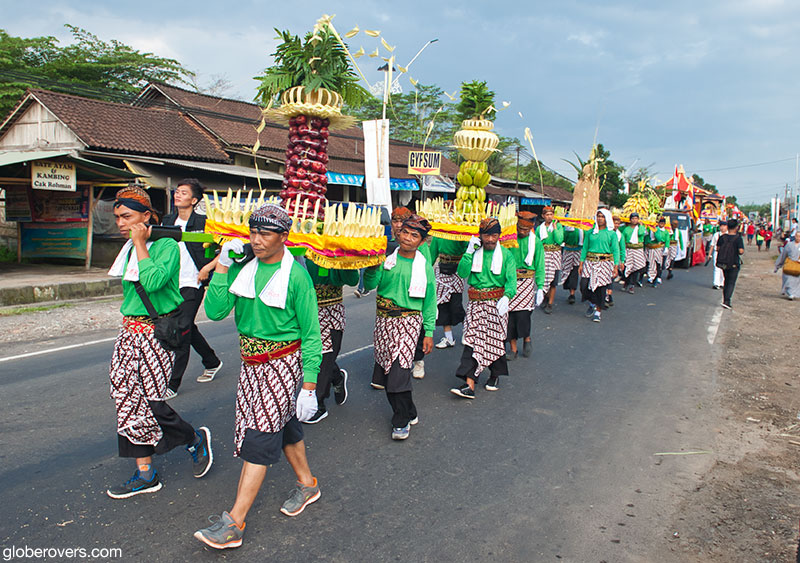
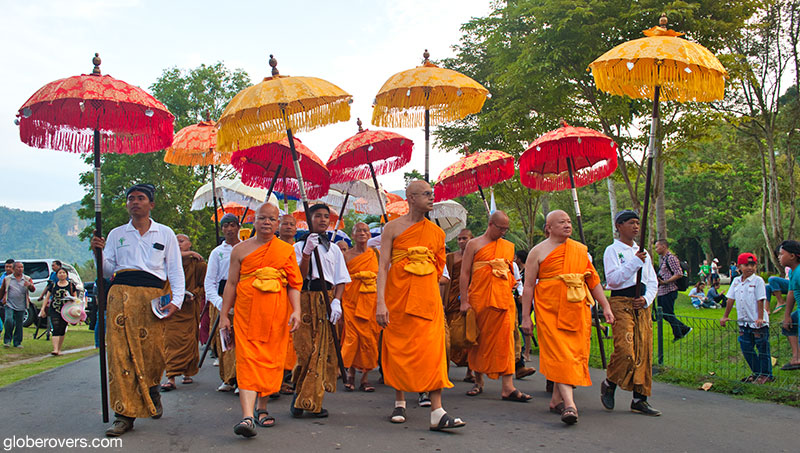
Even during high season, it is possible to have a peaceful time at the temple. The day before your intended visit, hop over to the Manohora Hotel, located near the main entrance, to buy your “sunrise tour” ticket at a hefty IDR 450,000 per foreigner.
At current rates, this amounts to about US$33. However, there is no limitation to the number of sunrise tickets the hotel sells, so technically you can purchase the ticket at the hotel ticketing counter at 4.20 am on the day you want to see the sunrise over Borobudur temple.

Included in the fee is a small flashlight which you will need when entering the temple grounds at about 4:30 am until the sun rises at around 5:40 am, depending on the time of the year you visit.
You will also be entitled to coffee and a snack at the time of leaving, but not later than 9 am when the hotel’s free coffee stand closes!
A regular day ticket, which allows you to enter at 6 am, costs $25, so the sunrise ticket is only $8 more. Is it worth this higher fee? Absolutely. At the time I visited there were about 30 of us who entered at 4:30 am. Between the time we entered, which was still quite dark, and the time of sunrise at 05:42 on May 12th, the light is at its best.

The best part of the sunrise was during the early twilight period before the sun actually peaked over the horizon. The blue and pink hues against the stupas and statues were surreal. By the time the gates opened at 6 am for the general public, the sun was already high and the magical hours were long gone. Along with the bright sunlight came the hordes of school children. I was amazed that the kids got up so early in the morning to see the temple.
Borobudur temple is a Mahayana Buddhist temple, and the world’s largest Buddhist temple. The imposing central dome, surrounded by 72 Buddha images inside perforated stupas, rests on top of nine stacked platforms that are decorated with 2,672 relief panels and the images of 504 Buddhas.

Following the decline of the Hindu kingdoms on Java Island as people increasingly converted to Islam, Borobudur’s importance started to diminish during the 10th or 11th century and was all but abandoned by the end of the 14th century. It then fell into ruins and was subsequently covered by volcanic ash and swallowed by the dense jungle. Some local superstitions associated the ruins with unfathomable bad luck, misfortunes, and misery, so people were forbidden to get near the ruins.
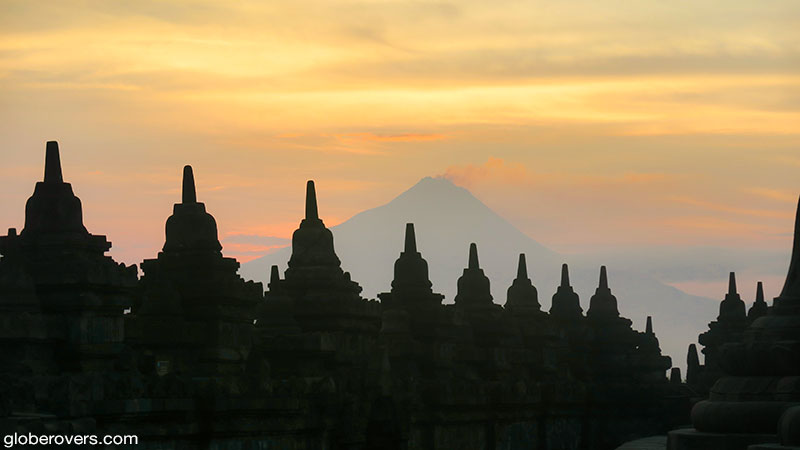
Forgotten and lost for centuries, it wasn’t until the early 19th century that Java’s British ruler, Sir Thomas Stamford Raffles, investigated rumours of a lost civilization in Central Java. With help from the local Indonesians, he roughly pinpointed the location and then sent H.C. Cornelius, a Dutch engineer, to find the temple.
With a load of natives alongside, he cut through the dense jungle for about two months to eventually reach the ruins. Sadly, they could see little of the ruined temple as it was mostly covered in jungle and volcanic ash. It took another 20 years before the entire temple complex was unearthed.
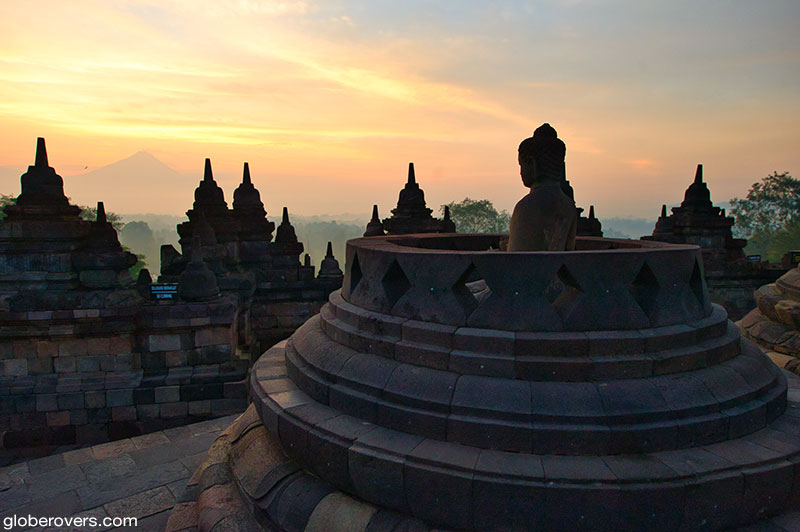
For the next few years, several expeditions arrived to survey the site and made detailed sketches of the temple remains. The first photograph was taken in 1872, most likely using a gelatin dry plate as photographic paper film was only invented in 1885. As more people became aware of the find, it attracted many “souvenir hunters” and thieves who plundered the ruins.
One of the “inspectors” who visited in 1882 even recommended that all the beautiful reliefs should be moved away to museums. In 1896, King Chulalongkorn of Thailand, then known as Siam, visited the area and took eight cartloads of sculptures, Buddha images and other items home with him, which are still on display in the Java Art room of The National Museum in Bangkok.
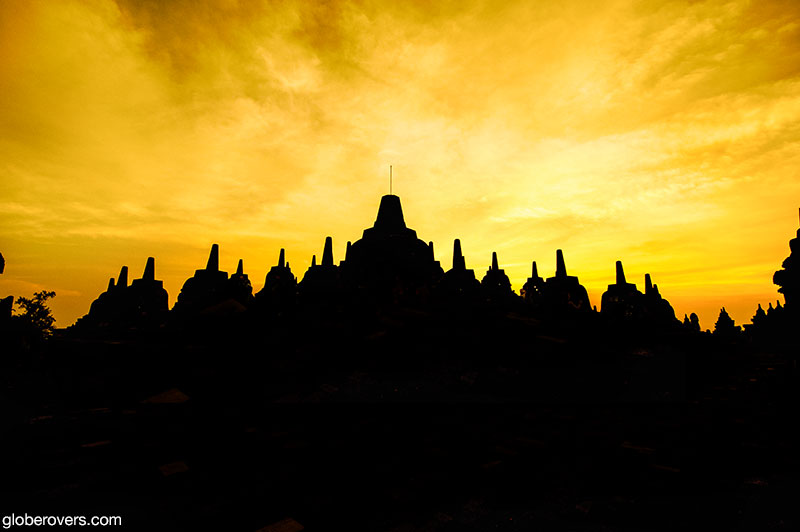
The first restoration of the temple commenced during the early 20th century. However, it was not until 1975 that the Indonesian government, supported by UNESCO, undertook a complete restoration. It took more than 600 workers, at a total cost of almost seven million US dollars to complete the project over the next seven years. The work has been compared to putting together the pieces of a massive one million-piece jigsaw puzzle. Borobudur was eventually listed as a UNESCO World Heritage Site in 1991.
The newly rebuilt temple continues to fight the daily onslaughts of the elements of destruction. In 1985, nine stupas were badly damaged by nine bombs, a bombing carried out by an Islamic extremist group. The Indonesian branch of ISIS recently threatened to destroy Borobudur and other statues in Indonesia.
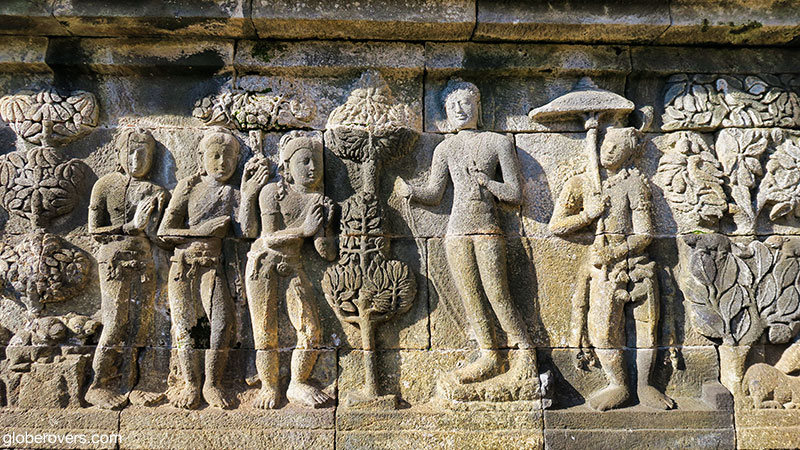
An ongoing threat is the overload of visitors trampling all over the brittle stone blocks, and don’t be surprised to find graffiti on the stones. The eruption of Mount Merapi in 2010 covered the temple in a layer of acidic volcanic ash up to 2.5 centimetres thick.
☛ Read more: 10 Great Travel Experiences in Indonesia
Spend at least three or four days in the town of Borobudur. While there are ample accommodation options, be sure to book months in advance if you plan to visit during any festive period, particularly during the Vesak Day festival.
Central Java is a gem. If you are into active volcanic action, including hiking up the slopes, or love visiting ancient temple ruins, Central Java is the place for you!
A few more photos of Borobudur Temple
More of Indonesia:



Blog post and photos by Peter who has been travelling almost full-time since 2005 and has been to over 122 countries. He visited several countries, such as Japan, more than 20 times. Peter is Editor-in-Chief and Publisher of GlobeRovers Magazine, an independent travel magazine focused on intrepid destinations.

